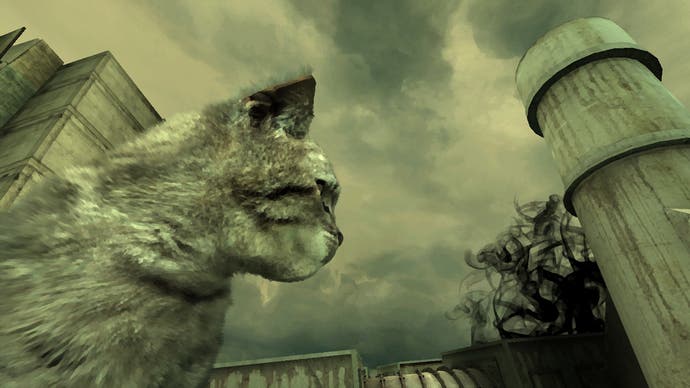Linger in Shadows
Scene but not heard.
It's a fair bet that a lot of people downloaded Linger in Shadows from PSN, perhaps enticed by its grungy visuals and impulse price point (GBP 1.99), only to be left utterly bewildered by the experience. To be fair, it's not as if Sony or Plastic, the coding team responsible, did a particularly good job of explaining what Linger in Shadows was going to be or what it was doing on PSN alongside more traditional gaming fare.
The official line is that it's an interactive art experience, with the official Sony webpage for the game offering the not-exactly-illuminating advice to "watch, enjoy, experiment and let the experience wash over you". Not the sort of thing likely to entice most gamers, at least not without a more concrete idea of what they're getting for their money.
To understand Linger in Shadows, then, you first need to understand the demoscene. This subculture of computer enthusiasts has its roots way back in the heyday of the home computer, and has nothing to do with demos as they are commonly used in gaming.
Scoot back to the 1980s and piracy was as prevalent as it is today. Rather than uploading their warez to torrent servers, amateur coders busy cracking the copy-protection on the latest Commodore 64 and ZX Spectrum games got into the habit of marking their work with an animated intro - or "cracktro" - inserted before the game began. Organised groups began to form, mostly in mainland Europe, and competition between the rival groups was fierce but mostly friendly. Think of it as the gaming equivalent of underground hip hop freestyle battles. But, you know, not quite as cool.

Over time, many groups drifted away from the tawdry business of software piracy and began to concentrate on refining their intro sequences as creations in their own right. This was the era of the Amiga and Atari ST, and the accompanying boom in public domain software. For the price of a floppy disc, anyone could sample the delights of a swirling starfield, a bouncing rendered 3D cube and undulating text across the bottom the screen, all set to a pounding techno beat. Demoscene events were held where groups such as Farb Rausch, MFX and Conspiracy, who had all risen to prominence from the mid-'90s onwards, would compete to see who could come up with the most impressive productions, pushing the hardware to its limits.
As computers became more powerful, and capable of ever more impressive visuals, so the demoscene became more technically adept and more artistically inclined. The community spirit was still there, but the creative output was much more sophisticated. Still amateur, still grassroots, the demoscene began to attract the attention of the increasingly industrialised games development community. Gifted coders, animators, graphic artists and musicians were sharing their best work for the approval of their peers, but it was only a matter of time before this underground talent resource was tapped by one of the industry heavyweights.

Which brings us to Linger in Shadows. A six-minute interactive animation, it tells a very abstract tale, set in some unnamed, crumbling urban environment. A column of black smoke tries to stop a flying spaniel from reaching an iconic statue, while a cat watches the struggle impassively from a nearby rooftop. The dog is turned to stone, which attracts the attention of a flying robot squid. It's a bit odd. According to Plastic's website, it's about "evil" but it should also be pointed out that fur, smoke and tentacles are all notoriously tough to render and animate. As always with the demoscene, showcasing your skill trumps narrative coherence every time.
There's clearly no tangible way to rate such a product using the traditional numerical scoring system, but we can at least gauge how successful it is as both a work of computer art and a demoscene standard-bearer for the console generation.

